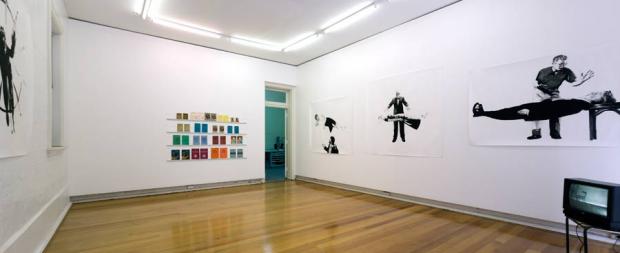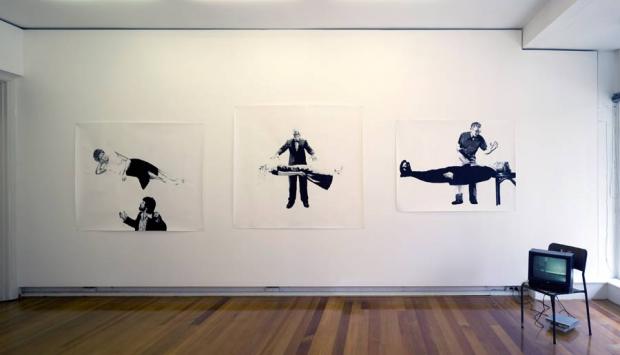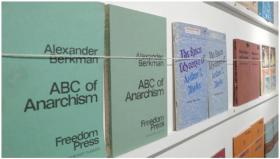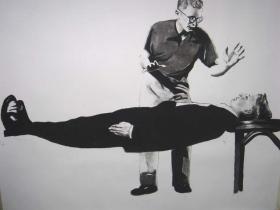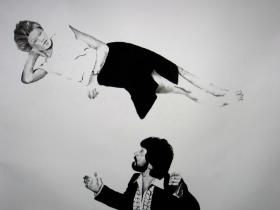solo projects
The Dark Arts
Simon Hollington & Adam Norton
26 february - 21 march 2009
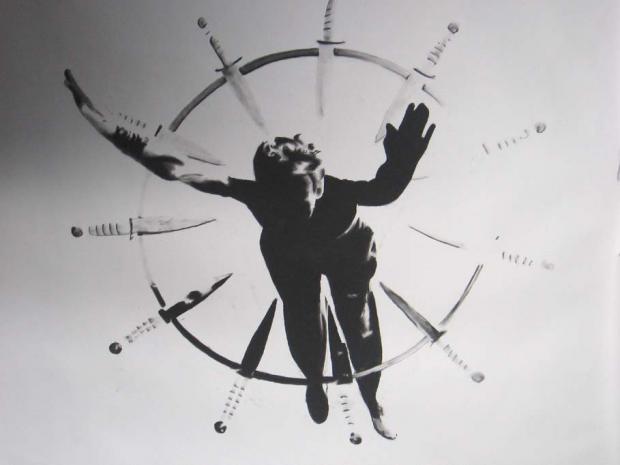
Gallery hours
Thursday to Saturday 1–6pm
Tel +612 9690 2601, info@peloton.net.au
19 + 25 Meagher Street, Chippendale NSW 2008, Sydney Australia
opening 6pm thursday 26 february
There is an old saying that says: ‘When the finger points to the moon, only the fool looks at the finger.’ But maybe a re-ordering may be needed: ‘When the finger points to the moon, only the fool looks at the moon.’ What if the moon is a distraction or the finger a misdirection as it is known in the art of magic? It’s not only the finger that needs to be kept an eye on, but what is the pointer doing with their other hand? Going through your pockets looking for a bob or two?
Magicians and mentalists employ this all the time. Often ‘hot readings’ (where the performer has done their research on their subject beforehand) were informed by employing pickpockets to quickly steal members of
the audience’s purses and wallets, noting down seat numbers and any personal details that could be ascertained, and then returning their spoils quickly and efficiently. But to be fair pick pocketing is an art, and the audience were all there to be tricked and lied to. That’s one of the good things about magicians and artists: they admit that it is all an illusion, a lie, and the audience are willing participants, some inspecting the act to find out how it’s done, and others just sitting back and enjoying the spectacle. Adam Norton’s and Simon Hollington’s illusions are produced in the same basic way, spreading different types of dirt on a flat surface, but coming from different perspectives.
Adam Norton’s piece, ‘The Library of Truth and Fiction,’ employs trompel’oeil, as booklets on display shelves sit next to almost exact replicas,but contain no information, just the meticulous painting of the cover, presented in the shape and size of the book. The verisimilitude of the piece is impressive, and so is the honesty—here’s my painting, this is where I copied it from—and it is this honesty that creates the cognitive two step in the viewer. We ‘read’ books, and we ‘read’ paintings, and this piece collides the two approaches, questioning the validity of both languages and the truth of the illusion. All the books are, or claim to be ‘factual’, and thus will contain many fictions—particularly as they are all of an age where some of the ‘knowledge’ contained within has been questioned or disproved. The paintings on the other hand, are what they are, artifice, illusions and allusions, and contain no fiction apart from this. Does this make them the real deal? The fact?
Simon Hollington picks up the end of the stick. The images are not photo realistic, and are taken entirely out of context. Magicians performing tricks are drawn without background or points of reference. The floating ladies (and they are invariably ladies) could be seen as an entirely different image rendered on the same page, but the stance of the magician implies that he is control, the manipulator of the image. As drawings, as images of magic they are bankrupt, and so any veracity of the image is redundant, and any moment of the sublime removed, creating an entropy of drama. The video ’Last Chance for a Slow Dance’ (made in collaboration with Kypros Kyprianou
carries on traditional illusionists and fake medium techniques to create seemingly poltern activity. The piece questions observable phenomena, the technologies of recording, and empirical data, and their relationship and effect upon the viewer.
In all these pieces our constructed nature of looking and seeing pulls us to read the images as what we know them to be—as books, as magic tricks, and at times impossible—and so the illusion is complete. The possibility of the impossible, and the ability to be both inside and outside an illusion at the same time is hard wired into the human mind. As Lou Reed once sang: ‘Believe none of what you hear, and only half of what you see.’
